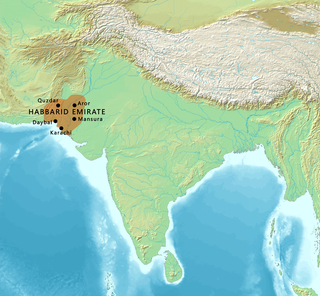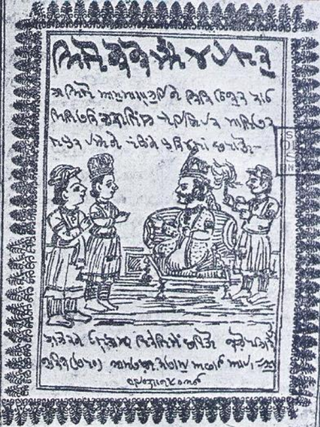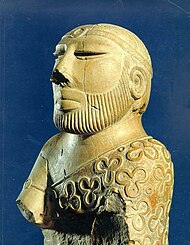
Sindh is a province of Pakistan. Located in the southeastern region of the country, Sindh is the third-largest province of Pakistan by land area and the second-largest province by population after Punjab. It is bordered by the Pakistani provinces of Balochistan to the west and north-west and Punjab to the north. It shares an International border with the Indian states of Gujarat and Rajasthan to the east; it is also bounded by the Arabian Sea to the south. Sindh's landscape consists mostly of alluvial plains flanking the Indus River, the Thar Desert of Sindh in the eastern portion of the province along the international border with India, and the Kirthar Mountains in the western portion of the province.

Abu al-Qasim Mahmud ibn Sabuktigin, usually known as Mahmud of Ghazni or Mahmud Ghaznavi, was Sultan of the Ghaznavid Empire, ruling from 998 to 1030. During his reign and in medieval sources, he is usually known by his honorific Yamin al-Dawla. At the time of his death, his kingdom had been transformed into an extensive military empire, which extended from northwestern Iran proper to the Punjab in the Indian subcontinent, Khwarazm in Transoxiana, and Makran.
Muslim Rajputs or Musalman Rajpoots are the descendants of Rajputs in the northern regions of the Indian subcontinent who generally are followers of Islam. Reportedly, they converted from Hinduism to Islam from the medieval period onwards, creating various dynasties and states while retaining Hindu surnames such as Chauhan. Today, Muslim Rajputs can be found mostly in present-day Northern India and Pakistan. They are further divided into different clans.
Soomro, Soomra,Sumrah or Sumra is a tribe having a local origin in Sindh. They are found in Sindh, parts of Punjab especially bordering Sindh, Balochistan province, and the Kutch district of the Indian state of Gujarat and also Rajasthan. The Soomras ruled throughout the Sindh and Multan regions.
The Samma dynasty was a medieval Sindhi dynasty which ruled the Sindh Sultanate from 1351 before being replaced by the Arghun dynasty in 1524.

Umerkot is a city in the Sindh province of Pakistan. The Mughal emperor Akbar was born in Umerkot in 1542. The folk deities Pabuji and Ramdev married in Amarkot.
Samma is a community called Sammat and a tribe that has origins in Sindh. The Samma are spread across Pakistan and North-West India. The Sandhai Muslims are Samma who converted to Islam. Offshoots of the main branch of Samma include the Jadejas and Chudasamas of India.

The history of Sindh refers to the history of the Pakistani province of Sindh, as well as neighboring regions that periodically came under its sway.
The Balochs of Sindh,, is a community of Sindhi-speaking Baloch tribes living throughout the Sindh province of Pakistan.
Zainab (Sindhi: زينب, romanized: Zaīnab, lit. 'a fragrant tree'; Sindhi pronunciation: [ze:n'əb], born Zainab Tari binte Dodo I Soomro was the 5th Sardarni of Soomra ruled Sindh, who ruled from 1089 till 1098. She succeeded the rule of her father Dodo I, who nominated her before he retired, as his younger son, Sanghar, was still a minor. Zainab is considered to be the second woman in the Islamic world, after Arwa al-Sulayhi, to rule over a kingdom.

The Habbari were an Arab dynasty that ruled much of Greater Sindh, as a semi-independent emirate from 854 to 1024. Beginning with the rule of 'Umar bin Abdul Aziz al-Habbari in 854 CE, the region became semi-independent from the Abbasid Caliphate in 861, while continuing to nominally pledge allegiance to the Abbasid Caliph in Baghdad. The Habbari ascension marked the end of a period of direct rule of Sindh by the Umayyad and Abbasid Caliphates, which had begun in 711 CE.
Abul Fateh Daud was a ruler from the Lodi dynasty of Multan who ruled the Emirate of Multan. He was deposed by Mahmud of Ghazni, who also massacred the Ismailis in the course of his conquest of Multan.

Emirate of Multan was a medieval Muslim emirate in Punjab that was centred around city of Multan, present-day part of Punjab, Pakistan. It was initially ruled by the tribe of Banu Munabbih. In 959 CE, Ismaili Qarmatians under Banu Lawi gained control of the Emirate and in 1010, it was conquered by Ghaznavid Empire.
The Jadgal is an Indo-Aryan ethno-linguistic group which speaks the Jadgali language. Jadgals are present in the Balochistan region of Iran and Pakistan, as well as in Oman.

Dodo Chanesar is a Sindhi ballad, set during the Soomro dynasty. The ballad is semi-historical in nature and a very importance source of information on medieval Sindh. It was preserved orally by professional minstrels over the centuries.
The Numria,Noomria or Nuhmardi are native Sindhi Rajput tribes of Sindh and Balochistan. The Numria people are principal inhabitants of the Lasbela and Kohistan regions.
The Sindhis of Balochistan are an indigenous Sindhi population living in Balochistan, Pakistan.

The Sindh Sultanate or historically romanized as Sultanate of Sind, was a medieval Indo-Islamic sultanate established in the mid 14th century primarily based in Sindh and some parts of Gujarat and Punjab. Following the defeat of Soomra Emirate by the Sammas, three dynasties ruled over the Sindh Sultanate sequentially: the Samma dynasty (1351–1524), the Arghun dynasty (1520–1554), and the Tarkhan dynasty (1554–1593).









